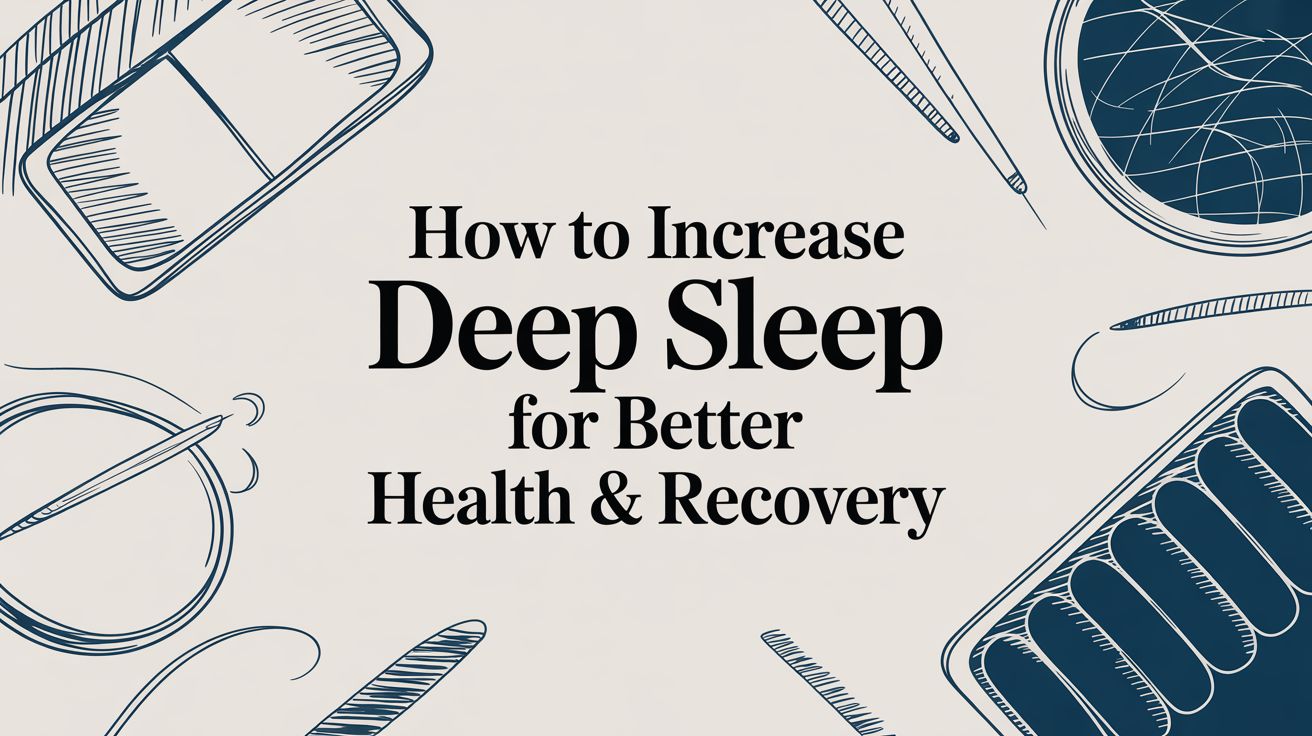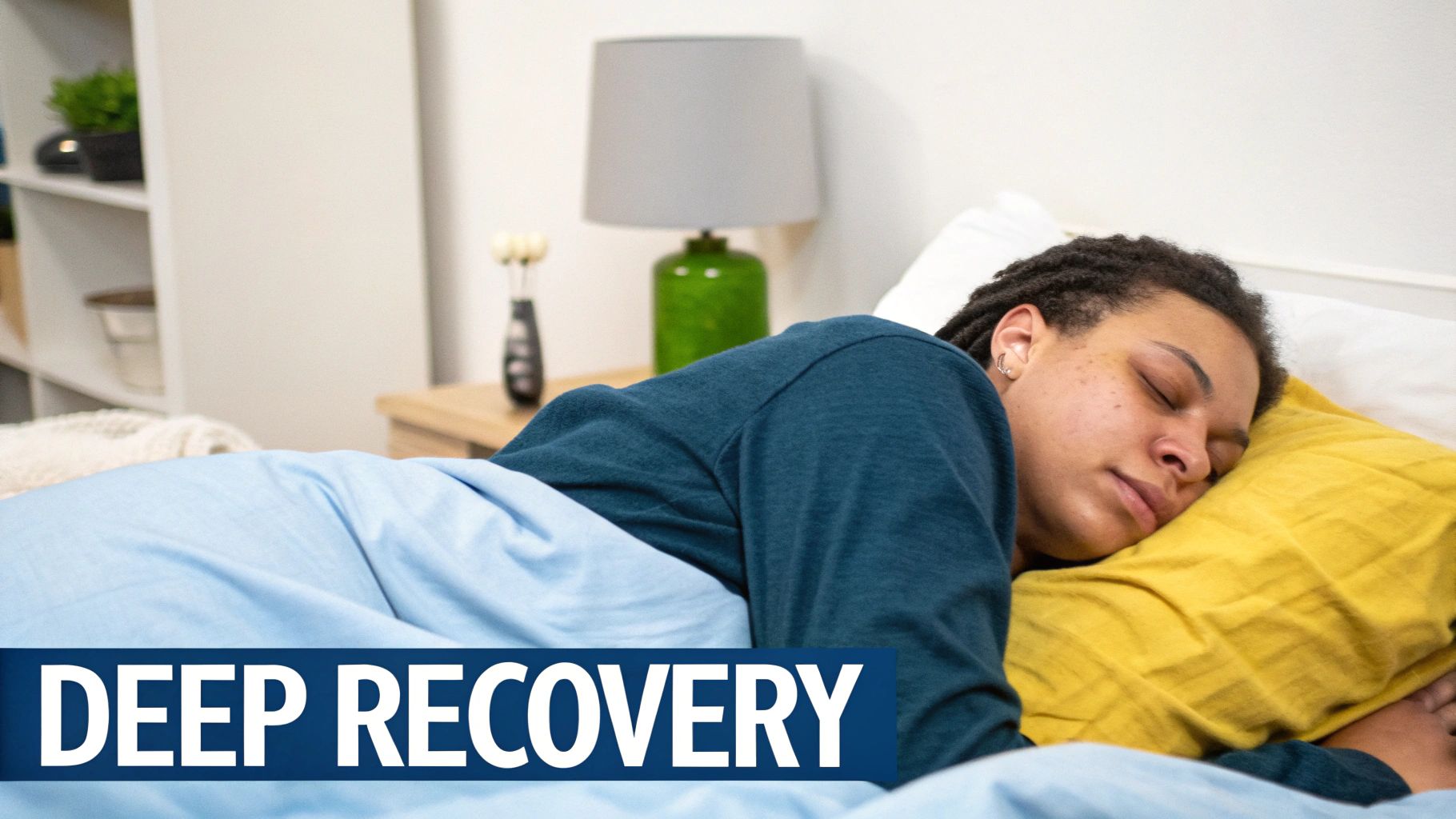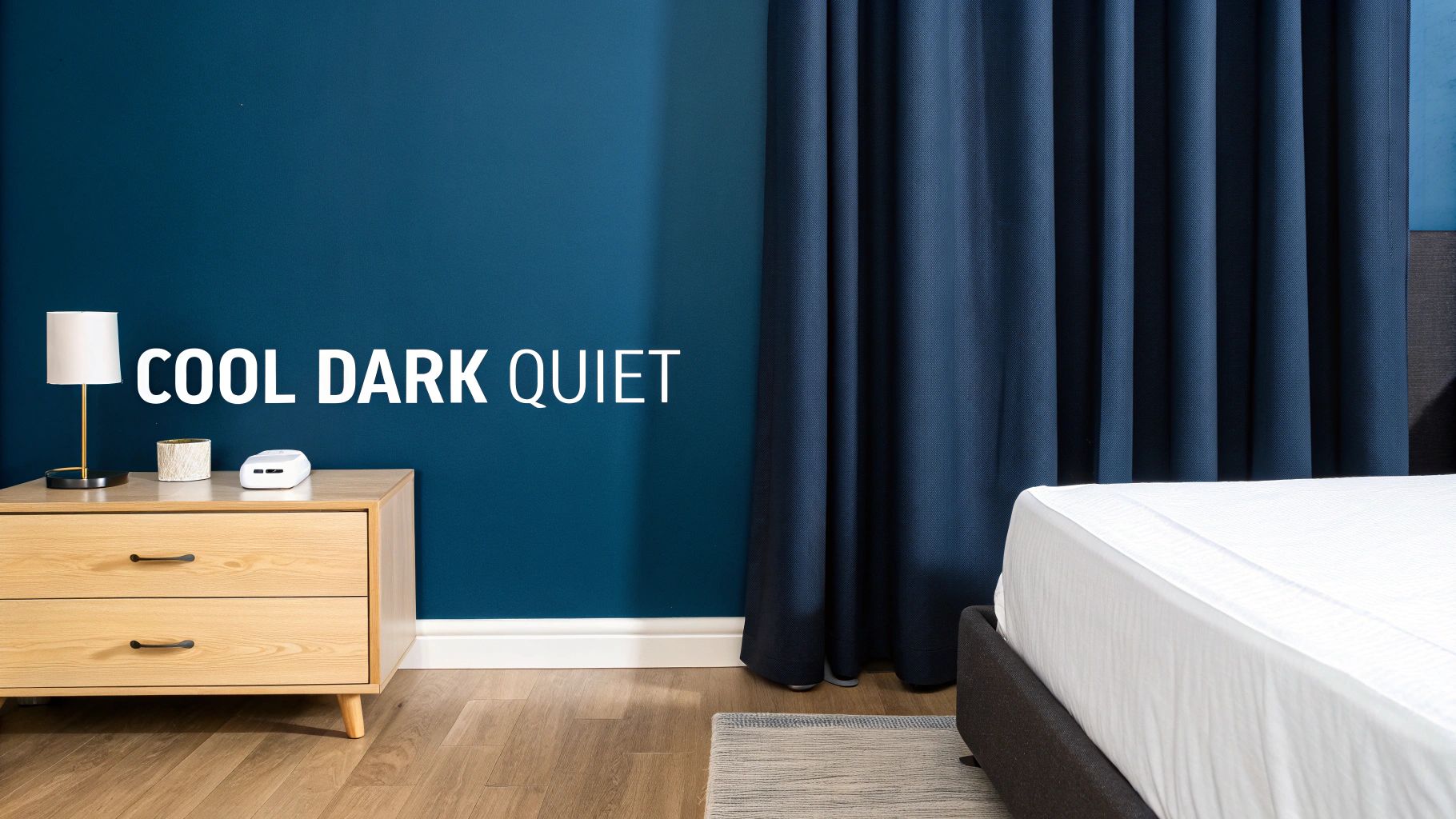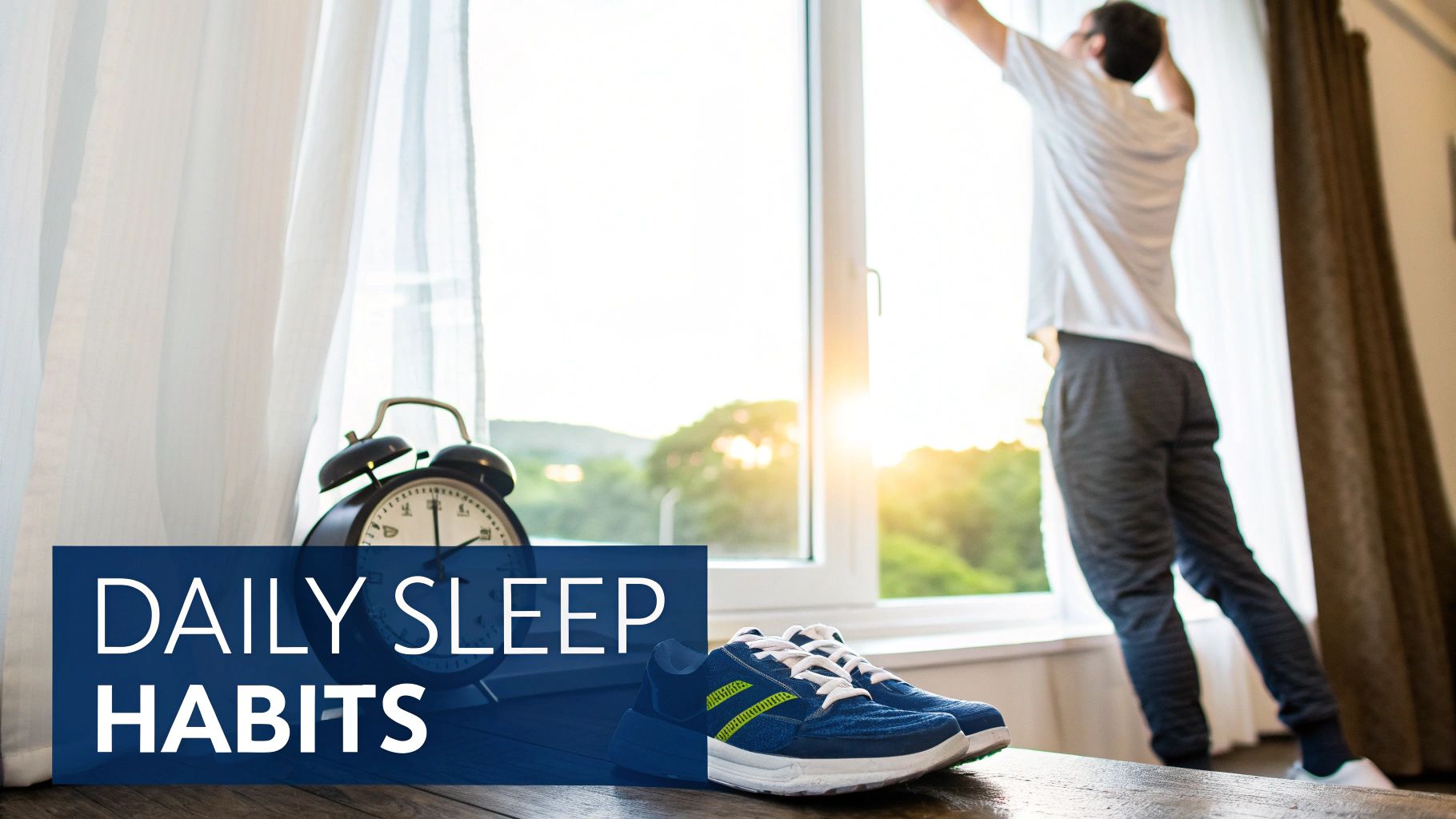
How to Increase Deep Sleep for Optimal Health & Workout Recovery
If you've ever woken up after a full eight hours still feeling drained, you've experienced the difference between sleep quantity and sleep quality. The real game-changer for your wellness isn't just how long you're in bed; it's how much time you spend in deep sleep.
This isn't just about feeling rested. Deep sleep is about tapping into your body's most powerful state of repair, rejuvenation, and recovery—a cornerstone of a proactive wellness lifestyle.
Why Deep Sleep Is Your Ultimate Wellness & Recovery Tool

Deep sleep, also known as slow-wave sleep, is where the real magic happens. Your brain waves slow to a crawl, your heart rate and breathing become steady, and your muscles fully relax. This is your body's designated time for heavy-duty maintenance and a critical component of your overall health.
It’s an active, non-negotiable process for anyone serious about health, performance, and long-term wellness. Without sufficient deep sleep, you're leaving workout recovery on the table and running on an empty tank.
The Foundation of Physical Recovery & Muscle Repair
For anyone who trains hard, deep sleep is when your body rebuilds. The pituitary gland gets to work, releasing a significant pulse of human growth hormone (HGH). This is the key that unlocks tissue repair, muscle growth, and bone strengthening, making it indispensable for effective workout recovery.
Skimp on deep sleep, and you'll feel it in your performance and your wellness. You're left with lingering soreness, a higher risk of injury, and plateaued results. It is the biological engine that turns yesterday's hard work into tomorrow's strength and resilience.
More Than Just Muscle Repair: The Full-Body Health Benefits
The wellness benefits of deep sleep go far beyond the gym, influencing nearly every system in your body.
- Immune System Fortification: During deep sleep, your body ramps up the production of cytokines—proteins that fight off infection and calm inflammation. Missing out leaves your immune defenses vulnerable.
- Cellular Cleanup & Brain Health: Think of it as a nightly power wash for your brain. The glymphatic system kicks into high gear, flushing out metabolic waste that accumulates while you're awake. This process is critical for long-term brain health and cognitive function.
- Hormonal Balance: Deep sleep is crucial for regulating key hormones like cortisol (stress) and insulin (metabolism). Just one night of poor deep sleep can disrupt this delicate balance, impacting everything from your mood to your body's ability to manage blood sugar.
- Memory Consolidation: While you're resting, your brain is busy filing away important information. Deep sleep helps transfer memories from short-term to long-term storage, locking in what you learned during the day.
Deep sleep is where the body prioritizes restoration. It's the biological equivalent of taking your car to the shop for a full engine rebuild, fluid change, and system diagnostic—all while you're peacefully unaware.
Optimizing recovery often involves targeted interventions that support these natural processes. For instance, enhancing cellular repair is a key goal of advanced wellness protocols. To see how oxygen fits into this picture, it's worth exploring the science of recovery and longevity through hyperbaric oxygen therapy.
Ultimately, getting this phase of sleep right is foundational for your health. For most healthy adults, deep sleep should make up about 10% to 20% of total sleep time. It’s a short but incredibly powerful window for your wellness.
To help you get started, here's a quick summary of the most effective strategies we'll be covering.
Quick Guide to Boosting Deep Sleep
This table provides a high-level overview of the interventions that can have the biggest impact on your slow-wave sleep. Think of it as your cheat sheet for better health and recovery.
| Strategy | Primary Benefit | When to Implement |
|---|---|---|
| Consistent Sleep Schedule | Aligns your circadian rhythm for predictable sleep cycles. | Daily, including weekends. |
| Cool & Dark Bedroom | A 1-2 degree drop in core body temp initiates sleep. | Nightly, starting 1-2 hours before bed. |
| Evening Light Discipline | Blocks blue light to allow natural melatonin production. | 2-3 hours before your target bedtime. |
| Strategic Exercise Timing | Raises body temp, followed by a sleep-inducing drop. | Morning or early afternoon is often best. |
| Mindful Evening Nutrition | Avoids digestive disruption and blood sugar spikes. | Finish last meal 3+ hours before bed. |
Each of these strategies plays a distinct role in signaling to your body that it's time to wind down and enter that deep, restorative state. Now, let's dive into the practical steps for making them happen.
Crafting the Perfect Sleep Environment
Your bedroom should be a sanctuary, a cave dedicated entirely to rest and rejuvenation. To truly move the needle on deep sleep, you have to treat your environment as a powerful wellness tool—one that signals safety and relaxation to your brain on a primal level.
This isn't just about tidying up. It's about taking deliberate control over the three core pillars of your sleep space: temperature, light, and sound.
Getting this right is one of the most direct and effective interventions you can make for your health. You’re essentially priming your body for the heavy-duty physical and mental restoration that only happens during slow-wave sleep. The downstream health benefits impact everything from workout recovery to your mental clarity the next day.

Master Your Temperature for Better Sleep
One of the most potent biological triggers for sleep is a slight drop in your core body temperature. By making your bedroom cooler, you're giving your body a head start on this natural process, making it far easier to fall asleep and stay in that restorative deep sleep stage.
The sweet spot for optimal sleep is between 60-67°F (15-19°C). This cool air helps your body shed heat, a non-negotiable step for initiating the sleep cycle. If your room is too warm, your body has to work to cool itself down, which can lead to fragmented sleep and rob you of precious time in those deep stages.
Think of this as a key lever for your workout recovery. A cool room doesn't just feel comfortable; it actively supports the release of growth hormone and the cellular repair that defines deep sleep.
The Power of Absolute Darkness
Your brain is incredibly sensitive to light. Even the tiniest pinprick from a phone charger can be enough to suppress melatonin, the hormone that orchestrates your sleep-wake cycle. When melatonin production is inhibited, your brain gets the message that it’s still daytime, compromising a core aspect of your wellness routine.
Your goal here is simple: make your room as dark as humanly possible. This is a biological necessity for high-quality rest.
- Blackout Curtains: This is non-negotiable. Invest in high-quality curtains that block all external light.
- Cover Small LEDs: Use electrical tape or a specialized sticker to cover indicator lights on your TV, power strips, and chargers.
- Wear a Sleep Mask: If you can't achieve total pitch-black, a comfortable, molded sleep mask is the next best thing.
A truly dark room tells your brain it's safe to completely shut down. This absence of light is a primary signal that allows your body to transition into and sustain the deep, uninterrupted sleep needed for optimal recovery and health.
Soundscaping for Uninterrupted Rest
Sudden, sharp noises can easily yank you out of deep sleep, even if you don't fully wake up. The solution isn't always complete silence, but rather a consistent, predictable soundscape created by a white noise machine.
It works by creating a constant, soothing auditory blanket that masks those abrupt, jarring sounds. Without this buffer, a sudden noise spikes your heart rate and disrupts your sleep architecture. But with white noise, that same sound gets absorbed into the background hum, allowing your brain to ignore it and stay in deep sleep. This stability is absolutely crucial for anyone serious about their workout recovery.
Finally, don't forget the foundation of it all: your mattress and bedding. If your mattress creates pressure points or traps heat, it's going to sabotage all your other efforts. Look for breathable materials that help regulate your body temperature, reinforcing that cool environment you've worked so hard to create.
Building a Pro-Sleep Daily Routine

Great sleep doesn't just happen by chance. It’s the direct result of smart, deliberate choices you make all day long. If you truly want to learn how to increase deep sleep, you need to build a daily rhythm that teaches your body when to be alert and when it’s time to power down for serious recovery.
This is all about anchoring your circadian rhythm—your body’s innate 24-hour clock. When that internal clock is stable, your body learns to anticipate sleep. The transition into those restorative deep stages becomes smoother and more efficient. For anyone serious about health and performance, this is a foundational wellness practice.
The Power of a Consistent Sleep Schedule
Your body craves routine. Going to bed and waking up at the same time every single day—including weekends—is arguably the most powerful lever you can pull to stabilize your circadian rhythm.
This consistency trains your brain to release sleep-promoting hormones like melatonin right on cue. Think of it as setting a precise biological timer for your most critical recovery functions. When your internal clock is dialed in, your body isn't left guessing when to initiate deep sleep—it just knows.
Harnessing Morning Sunlight
Light is the master signal for your internal clock. Getting 10 to 15 minutes of direct, natural sunlight in your eyes within the first hour of waking is non-negotiable for optimizing your sleep.
This simple act accomplishes two critical health tasks:
- It halts melatonin production, sending a clear signal to your brain that the day has begun.
- It sets a countdown timer for melatonin to start rising again roughly 16 hours later, perfectly timed for when you want to wind down.
This habit locks in your circadian rhythm, making your bedtime feel natural instead of forced. It's a free, potent wellness tool for preparing for a night of deep rest.
By getting sunlight in the morning, you are essentially pre-programming your brain for a better night's sleep. This act anchors your entire 24-hour cycle, making deep sleep far more attainable.
Strategic Exercise for Enhanced Deep Sleep
Regular physical activity is great for sleep, but when and how you exercise matters. Exercise raises your core body temperature. A few hours later, as your temperature drops, it mimics the body's natural cool-down process that helps initiate sleep, often leading to more robust deep sleep and better workout recovery.
For most people, a morning or early afternoon workout is the sweet spot. This leaves plenty of time for that crucial post-exercise temperature drop.
- Best Time: Morning or early afternoon to capitalize on the post-exercise cool-down effect.
- What to Avoid: High-intensity interval training (HIIT) or heavy lifting within three hours of bedtime.
- Evening Option: If you must exercise at night, choose something restorative like yoga or gentle stretching.
Caffeine and Alcohol: The Deep Sleep Saboteurs
Caffeine and alcohol are two of the most common culprits that wreck sleep quality and overall wellness. While they might feel like a necessary crutch, both can devastate your sleep architecture, with deep sleep often taking the biggest hit.
Caffeine’s half-life is around five to six hours, meaning a 2 PM coffee can easily disrupt your sleep at 10 PM. To protect your deep sleep, establish a firm rule: no caffeine after noon.
Alcohol is a sedative, so it might make you feel drowsy faster. But as your body metabolizes it, the process becomes incredibly disruptive. It fragments your sleep, causing you to wake up and severely suppressing both REM and deep sleep stages. To minimize the damage, stop drinking at least three hours before bed.
Interestingly, many people find that a hot sauna session provides a similar sense of full-body relaxation without torpedoing their sleep. You can explore various at-home saunas that support wellness routines as a healthier alternative for winding down.
Fueling Your Body for Deeper Sleep
What and when you eat has a massive impact on your ability to get restorative deep sleep. Your nutrition choices can either stabilize your blood sugar and provide the raw materials for sleep hormones, or they can create digestive issues and hormonal chaos that undermine your rest and health.
Think of your evening meal as a key part of your wellness strategy. A heavy, high-fat meal close to bed forces your digestive system to work overtime right when it should be powering down. This can raise your core body temperature and heart rate, directly sabotaging the physiological cool-down your body needs to drop into deep sleep.
Building Your Sleep-Friendly Plate
The goal for your last meal is simple: feel satisfied and keep your blood sugar stable without overburdening your gut. This comes down to a smart balance of complex carbs, lean protein, and healthy fats, which ensures a slow, steady release of energy and prevents blood sugar crashes that can jolt you awake.
A solid evening meal might look something like this:
- Complex Carbohydrates: Sweet potatoes, quinoa, or brown rice can help increase the availability of tryptophan in the brain, the precursor to serotonin and melatonin.
- Lean Protein: Chicken, turkey, or fish provides the building blocks for tissue repair, a key function of deep sleep and essential for workout recovery.
- Healthy Fats: A little avocado or a drizzle of olive oil can promote satiety, helping you avoid late-night hunger pangs.
Aim to finish your last big meal at least three hours before bedtime. This gives your body plenty of time for digestion before it needs to shift its focus to cellular repair and memory consolidation.
Foods That Naturally Promote Deep Sleep
Beyond macros, certain foods contain specific compounds that directly support your sleep architecture and overall wellness.
One of the most important players is magnesium. This mineral is a powerhouse for relaxation, helping to regulate neurotransmitters that calm the nervous system and playing a direct role in melatonin production. You can find it in leafy greens like spinach, almonds, pumpkin seeds, and legumes.
Your body uses specific nutrients as raw ingredients to manufacture the hormones and neurotransmitters that govern sleep. Without an adequate supply of compounds like magnesium and tryptophan, your brain simply can't run the sleep-initiation playbook effectively.
Another key player is tryptophan, an amino acid famous for its role in sleep. It’s a direct building block for serotonin, which your body then converts into melatonin. Besides turkey, you'll find it in eggs, cheese, and nuts. Pairing tryptophan-rich foods with complex carbs can make it more available to your brain, enhancing its sleep-promoting effects.
A Smart Approach to Supplementation
While whole foods should always be the priority, targeted supplementation can be a powerful ally for wellness. If your diet has gaps or you need extra support, a few select supplements can make a real difference.
- Magnesium Glycinate: One of the best forms of magnesium for sleep, it’s highly bioavailable and gentle on the stomach. It’s known for its calming effect on the nervous system.
- L-Theanine: Found in green tea, this amino acid promotes a feeling of calm without drowsiness. It increases alpha brain waves—the same ones that appear during meditation—which can help quiet a racing mind.
If you decide to try supplements, start with a low dose and consult with your doctor to ensure they are a good fit for your health needs. By fueling your body with intention, you create the perfect internal conditions for a truly restorative night.
Advanced Techniques for Sleep and Recovery
So you've nailed the fundamentals, but you're still chasing that extra edge in your wellness routine. This is where advanced recovery protocols come in. These are powerful tools for dialing in deep sleep, especially if you're serious about workout recovery and calming your nervous system.
These methods often work on the principle of hormesis—using a small, controlled stressor to trigger a powerful adaptive response from your body. In the context of sleep, it’s about intentionally manipulating your body's internal environment to signal that it's time for deep, restorative rest.
Using Temperature to Your Advantage: Contrast Therapy
One of the most potent strategies is contrast therapy: alternating between hot and cold. Think a hot sauna session followed by a cold plunge or even just a very cold shower. This rapid temperature shift is like a hard reset for your autonomic nervous system, making it a powerful wellness tool.
The heat from a sauna relaxes tight muscles, while the shock of the cold constricts blood vessels. This push-pull effect helps flush metabolic waste and dials down inflammation—a huge win for workout recovery.
For sleep, the real magic is twofold:
- It calms your nervous system. The intense cycle can pull you out of a "fight-or-flight" state and into a relaxed "rest-and-digest" parasympathetic mode.
- It exaggerates your body's natural sleep signal. The sauna raises your core temp, so the cool-down that follows is more dramatic, sending a loud and clear message to your brain that it's time to shut down.
By deliberately manipulating your body temperature a few hours before bed, you're essentially biohacking your body's natural sleep-wake cycle. You’re giving it the exact signals it’s looking for to initiate deep sleep.
Red Light Therapy for Circadian Rhythm Support
Another impressive wellness tool is red light therapy (RLT). This involves exposing your body to specific wavelengths of red and near-infrared light. Unlike the sleep-wrecking blue light from our screens, these longer wavelengths are believed to support cellular energy and help anchor your internal clock.
Using a red light device in the evening can be a surprisingly calming ritual. Some research suggests it might even support your body’s own melatonin production. It’s a great addition to a wind-down routine, especially during dark winter months. If you want to dive deeper, you can explore the benefits of red light therapy and see how it fits into a bigger wellness picture.
The infographic below breaks down some of the key nutrients that provide the raw materials your body needs for quality sleep.
As you can see, things like Magnesium, Tryptophan, and natural sources of Melatonin all play a crucial role in preparing your body for rest.
Comparing Advanced Recovery Tools for Sleep
With so many wellness options, it can be tough to decide where to invest. This table offers a quick comparison of advanced recovery methods to help you figure out what might work best for your goals.
| Technique | Potential Sleep Benefit | Considerations (Cost, Access) | Best For |
|---|---|---|---|
| Sauna (Hot) | Promotes muscle relaxation, raises core body temp for a subsequent drop that signals sleep. | Moderate to high cost for home units. Gym/spa access is more affordable but less convenient. | Individuals with muscle soreness or who feel "wired" before bed. |
| Cold Plunge (Cold) | Reduces inflammation, activates the parasympathetic nervous system (after the initial shock). | Can be DIY for low cost, but high-end units are expensive. Requires mental toughness. | Athletes focused on reducing post-workout inflammation and building resilience. |
| Red Light Therapy | Supports circadian rhythm and may aid melatonin production without disruptive blue light. | Low to moderate cost for quality home panels. Requires consistent daily use. | Anyone looking for a non-invasive, calming evening routine to counter screen time. |
| HBOT | Increases oxygen saturation in tissues, potentially reducing systemic inflammation and stress. | Very high cost and generally requires access to a specialized clinic. | Those with significant recovery needs, chronic inflammation, or seeking cutting-edge protocols. |
Ultimately, the "best" tool is the one that fits your budget, you can access consistently, and that your own data shows is making a positive difference for your health.
Adopt a "N-of-1" Mindset
Here’s the most important part: you have to treat this like a personal experiment. What sends my deep sleep through the roof might do nothing for you. This is where your sleep tracker becomes your most valuable piece of gear.
Don't just add a sauna session and cross your fingers. Track your data. See what happens to your deep sleep, your heart rate variability (HRV), and your resting heart rate.
Does a 15-minute sauna two hours before bed work better than a 30-minute session? Does that cold plunge right before bed leave you feeling calm or jacked up?
Use the data to make decisions. That’s how you go from just having "good" sleep to having a truly optimized recovery protocol that is built specifically for you.
Common Questions About Increasing Deep Sleep
Even with the perfect plan, questions will arise. You're working with your own unique biology, and troubleshooting is part of the process. Let’s tackle some of the most common issues people face when dialing in their deep sleep for better health.
How Long Does It Take to See Improvements in Deep Sleep?
This is the big one, and the honest answer is: it depends.
Some people feel a real shift in energy within just a few days of making foundational changes—like blacking out their room and locking in a consistent sleep schedule. Those environmental and behavioral cues can work surprisingly fast.
But for others, especially if you're unwinding years of habits like late-night caffeine or a chaotic bedtime, it can take several weeks to see a meaningful trend on your sleep tracker. You're essentially retraining your body's internal clock, and that takes time. Consistency is everything. One great night won't erase weeks of poor habits, but sticking with your new routine will gradually teach your body to prioritize that restorative, slow-wave sleep.
Can Napping Help Increase My Total Deep Sleep?
Napping can be a double-edged sword for your wellness. A quick, 20-minute "power nap" early in the day? Fantastic for a jolt of alertness without messing with your night. The trouble starts with long naps or napping too late in the afternoon.
These longer, later naps can obliterate your sleep pressure—the natural, biological drive for sleep that builds all day long. If you take too much of that pressure off with a nap, you'll find it much harder to fall asleep later. This can shorten your total sleep time and cut right into your deep sleep stages.
So, while a short nap can be a lifeline when you're seriously sleep-deprived, it's not a reliable strategy for increasing your deep sleep percentage. Prioritizing one solid block of sleep at night is always the better approach for recovery and health.
Are Sleep Trackers Accurate at Measuring Deep Sleep?
Consumer sleep trackers are incredible tools, but you have to understand what they are—and what they aren't. They are excellent estimators, not clinical-grade sleep lab machines. These devices use metrics like motion, heart rate, and heart rate variability (HRV) to make an educated guess about your sleep stages.
Think of your tracker's deep sleep number as a trend indicator, not gospel. Its real value is in showing you how your habits—that late meal, an evening workout, trying contrast therapy—correlate with your sleep quality over time.
Focus on the big picture. If you implement a new protocol and see your deep sleep trend upward over the next week, that's a powerful insight. Don't obsess over the exact number from a single night; use the data to confirm your efforts are moving the needle in the right direction for your wellness goals.
What Should I Do if I Wake Up During the Night?
First off, waking up briefly is completely normal. The real problem is when you can't get back to sleep.
If you find yourself wide awake for more than 15-20 minutes, the best thing you can do is get out of bed. Lying there stressing about not sleeping only creates a vicious cycle, training your brain to associate your bed with anxiety.
Go to another room with dim light and do something relaxing and screen-free. Read a physical book (nothing too gripping), listen to some ambient music, or do some light stretching. The most important rule: do not check the time. When you feel sleepy again, head back to bed. This technique, known as stimulus control, is a game-changer for retraining your brain to see your bed as a place for one thing only: sleep.
At MedEq Fitness, we believe that true performance is built on a foundation of elite recovery. From saunas and cold plunges that reset your nervous system to red light therapy that supports your natural rhythms, our physician-led team has curated the best science-backed wellness tools to help you master your sleep and unlock your full potential. Explore our collection and start building your ultimate recovery sanctuary today at https://www.medeqfitness.com.


